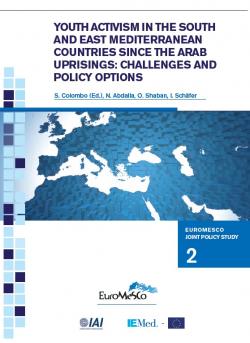Youth Activism in the South and East Mediterranean Countries since the Arab Uprisings: Challenges and Policy Options
Se ci si occupa dei giovani del Medio Oriente e Nord Africa occorre riconoscere che si tratta di una categoria non omogenea. A seconda della loro estrazione sociale e della loro cultura, classe, genere e etnia, le esigenze e richieste socioeconomiche di questi giovani sono state differenti e si sono espresse in modo diverso. Se si guarda all’esperienza dei singoli paesi nel Sud ed Est del Mediterraneo (Sem), si osserva che la risposta dei governi e le loro politiche tendono a differire notevolmente. La prima parte di questo studio offre un’analisi dello scenario complessivo, finalizzata a comprendere questa complessità e le diverse rivendicazioni, forme e strategie dell’attivismo giovanile relativo alle questioni socioeconomiche. I capitoli successivi analizzano il caso dell’Egitto e quello della Palestina, mettendo così in evidenza gli aspetti specifici dell’attivismo giovanile nella regione. Il contributo finale, con un focus sulla Tunisia, analizza il potenziale contributo delle politiche dell’Unione europea nel promuovere un approccio attento alla questione giovanile.
Risultato finale del Working Package “Youth Activism in the South and East Mediterranean Countries since the Arab Uprisings: Challenges and Policy Options”, guidato dall’Istituto Affari Internazionali (IAI) nell’ambito del progetto EuroMeSCo “Euro-Mediterranean Political Research and Dialogue for Inclusive Policy-Making Processes”.
-
Dati bibliografici
Barcelona, European Institute of the Mediterranean, febbraio 2016, 74 p. (EuroMeSCo Joint Policy Study ; 2)
1. Youth Activism, Government Policies and the Role of the EU, Silvia Colombo, p. 7-24
Introduction
1.1 The Impact of Government Policies on Youth Exclusion/Inclusion
1.2 Framing Youth Activism in the South and East Mediterranean Countries
1.3 The EU’s Youth-Relevant Policies and Approach in the South and East Mediterranean Countries
1.4 Conclusions and Outline of the Other Chapters of the Policy Study
Bibliography
2. The Quest for Accountability and Socio-Political Change in Egypt: Repertoires of Actions and Challenges for Youth Activism at the Local Level, Nadine Abdalla, p. 27-43
Introduction
2.1 Advocacy and Training: A Way to Increase Youth Inclusion?
2.2 Creating and Supporting “Popular Committees”: A Way to Empower People?
2.3 Playing a Mediating Role: A Way to Build Local Lobbies and Social Capital?
2.4 Conclusions and Recommendations
Bibliography and Background references
3. The Arab Spring and the Palestinian Youth Movement: Different Challenges and Priorities, Omar Shaban, p. 45-59
Introduction
3.1 The Political Context
3.2 The Arab Spring: Palestinian Youth Hopes
3.3 A Palestinian Spring?
3.4 Palestinian Youth Actions and Forms of Mobilisation
3.5 An Extreme Form of Resistance. Neither Intifada, nor Military Resistance: the Habbah
3.6 “Arab Winter”, “Palestinian Winter”: Disillusion and Radicalisation?
3.7 Conclusions and Recommendations
Bibliography
4. Fostering a Youth-Sensitive Approach in the EU’s Policies towards the South and East Mediterranean Countries – The Case of Tunisia, Isabel Schäfer, p. 61-74
Introduction
4.1 Aspirations and Concerns of Tunisian Youth(s)
4.2 Fostering a Youth-Sensitive Approach in EU Policies
4.3 The EU’s Toolkit to Tackle Youth Challenges in the SEM Countries
Bibliography and Background references
Tema
Tag
Contenuti collegati
-
Ricerca06/01/2014
Euro-Mediterranean Study Commission - EuroMeSCo
leggi tutto




